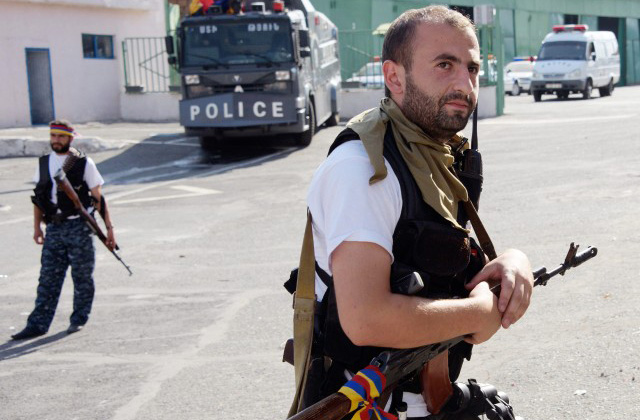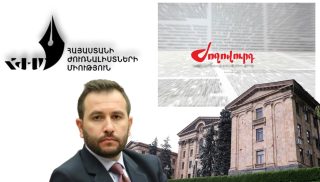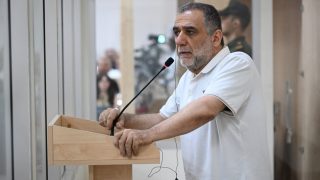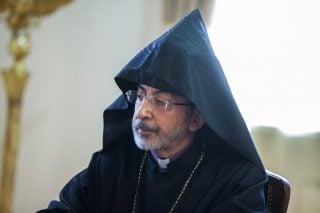
Sarkisian is Stuck between a Rock and a Hard Place: Stratfor

A standoff in Yerevan, Armenia, started when a group unhappy with Armenia’s concessions in the Nagorno-Karabakh dispute stormed a police station, seizing hostages. Popular support for the group has made a solution to the standoff elusive.
Summary
Armenia is now 12 days into a tense standoff between security forces and the Founding Parliament, an armed group that stormed a police office in Yerevan on July 17 and has occupied the building since. Among other motives, the group has cited Armenia’s recent losses around the breakaway territory of Nagorno-Karabakh as a reason for the attack. In the face of the government’s failure to resolve the situation, citizens have taken to the streets to protest officials’ handling of the crisis. The incident has revealed just how little room the administration of President Serzh Sarkisian — already under pressure from Russia and the West to end the impasse with Azerbaijan over the disputed region — has to maneuver.
Analysis
In the early morning of July 17, a group of armed men seized the Erebuni district police headquarters in central Yerevan, killing one police officer and wounding four more. The gunmen seized hostages and issued numerous demands. Chief among them was the release of Founding Parliament leader Jirair Sefilian, a critic of the Armenian government who was arrested and detained in June on charges of possessing illegal weapons. The group also called for the release of other political prisoners and for Sarkisian’s administration to step down.
Before the attack, the Founding Parliament was a little-known faction on the fringe of the Armenian opposition. It has shown how effective it can be, however, in both carrying out an operation and sustaining it, a capability that can largely be explained by its membership, which includes veterans of the Nagorno-Karabakh War. The group named the loss of territory around Nagorno-Karabakh during a military escalation in the region in April as a motive for the attack. The Founding Parliament also expressed frustration over Sarkisian’s consolidation of power and crackdowns against his rivals.
No Clear Solution
These issues have resonated with some segments of the Armenian population, and protesters in Yerevan have offered support for the Founding Parliament while lambasting Sarkisian’s administration. Several protests have taken place over the past two weeks, including one on July 25 that drew 2,000 to 3,000 people and led to violent clashes between civilians and police. The popular response has given the government pause in its handling of the Founding Parliament: Security forces have refrained from launching a large operation against the group, opting instead to pursue a combination of talks and targeted confrontations.
So far, this strategy has yielded mixed results. Though all of the original hostages have been released, continuing tensions with authorities prompted members of the group on July 27 to seize medical workers who were treating their injured comrades. The same day, though, two of the Founding Parliament fighters surrendered, and the group’s leader and his son were reportedly wounded in an overnight shootout with police.
Coupled with the ongoing protests, which spread to the city of Gyumri on July 28, this turn of events makes it unclear when and how the incident will be settled. Most Armenians see the Founding Parliament’s forceful and illegal takeover of the police building as too aggressive, and the taking of more hostages will likely further sour the public’s opinion. At the same time, popular dissatisfaction with the government’s actions is rising. It will therefore be important to watch what measures are used to end the standoff. Too harsh a response could trigger larger and more widespread demonstrations, while too weak a response risks dragging out a situation with unpredictable consequences.
Problems Abroad Have Domestic Consequences
Beyond the immediate tactical dilemma, the hostage crisis has exposed a bigger problem for the Armenian government. Since the clash in April, a flurry of diplomatic activity mediated by Russia and the West has taken place between Armenia and Azerbaijan in search of a political resolution to the conflict — something that has remained elusive since the countries signed their original cease-fire in 1994. Because Armenia won that war, Yerevan would prefer to maintain the current political and territorial status of Nagorno-Karabakh. Azerbaijan naturally has an interest in challenging it. The April stunt was a means to present that challenge by forcing the revival of talks and inducing Russia — Armenia’s traditional ally — not only to withhold its support for the Armenian military but also to pressure Yerevan into taking the negotiations seriously.
The talks have undermined the Armenian government’s position at home. Many Armenians fear that Sarkisian will grant political and territorial concessions to Azerbaijan to prevent a broader military engagement over the disputed region. The mere possibility of a compromise over Nagorno-Karabakh can topple an Armenian government; Levon Ter-Petrosyan was forced to resign as president in 1998 after he tried to reach a deal with Azerbaijan on the breakaway territory.
Sarkisian is stuck between a rock and a hard place. On one hand, Russia and the West are pushing Yerevan to make progress on finding a political solution to the Nagorno-Karabakh issue. But on the other, Sarkisian is aware that any major concessions could threaten his position in office, and potentially even topple the government. Though the hostage crisis is not driven solely by concerns over Nagorno-Karabakh, it is strongly influenced by them and is proof of the instability that a diplomatic deal on the region could produce. Combined with the population’s rising discontent with security crackdowns, centralization of power and corruption that are associated with Sarkisian’s rule, the standoff with the Founding Parliament has further weakened the government’s grip.























